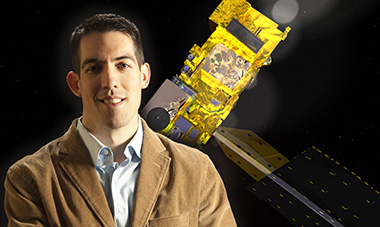UAlbany Researcher Receives NOAA Young Scientist Award for Satellite Remote Sensing
 |
|
Craig R. Ferguson, using microwave and infrared sensors on NASA’s Aqua Earth Observing System satellite, resolved which weather and climate models correctly represent land-atmospheric interaction, paving the way to refine the models. (Photo by Mark Schmidt) |
ALBANY, N.Y. (March 27, 2014) -- University at Albany hydrologist Craig R. Ferguson has received a prestigious National Oceanic and Atmospheric Administration (NOAA) honor for developing a pioneering approach in satellite remote sensing. The technique addresses one of the most important and vexing scientific issues facing operational weather and climate models – determining whether the models correctly represent how land and atmosphere interact.
Ferguson, a research associate in UAlbany’s Atmospheric Sciences Research Center (ASRC), received NOAA’s David S. Johnson Award, which recognizes young professionals who are finding new and innovative ways to enhance or redefine the use of Earth observation satellite data for inclusion in operations at NOAA. The award was presented March 7 at the National Space Club’s 57th Annual Goddard Memorial Dinner.
“The Johnson award spotlights exemplary work young scientists like Dr. Ferguson are performing with satellite data that benefit society,” said Mary Kicza, assistant administrator for NOAA’s Satellite and Information Service.
Ferguson has done extensive research on the application of satellite remote sensing in the areas of soil moisture and terrestrial evapotranspiration, land-atmosphere interactions, and the global hydrological response to climate change, among other climate-relevant topics.
Improved weather and climate forecasting at longer lead times allows additional time for coping and adaptation to severe weather and climate change, respectively. A key source of inter-model disagreement historically has been the strength of the land surface’s role in weather and climate predictability.
Ferguson, however, pioneered research using microwave and infrared sensors on NASA’s Aqua Earth Observing System satellite that, for the first time ever, resolved which models tended to correctly represent regional land-atmospheric coupling and feedbacks. This work has paved the way for comparison, evaluation and refinement of models.
At ASRC, Ferguson is now building a modelling team to collaborate on improving sub-seasonal to seasonal forecast skills by incorporating these satellite-observed tendencies. It will consist of Dr. Hyo-Jong Song from the Korea Institute of Atmospheric Prediction Systems, who arrives in April as a postdoctoral associate, and visiting scholar Dr. Minhee Lee from Seoul National University. Ferguson also hopes to add a first-year graduate student to the group.
UAlbany’s Vice President for Research, James A. Dias, said “the University is delighted that Dr. Ferguson has been recognized by NOAA in this special way for his pioneering work.” He noted that Ferguson is part of a cluster of newly hired faculty underwritten by Governor Andrew M. Cuomo’s landmark NYSUNY 2020 Program.
Since the inception of its NYSUNY 2020 plan, the University has hired 12 new faculty in atmospheric and environmental science. This cohort has attracted a combined total of more than $14 million in external funding awards in just the past several years.
“The University is proud of all its atmospheric and environmental researchers who are performing critical work in the advancement of extreme weather forecasting, while at the same time, helping to ensure that New York’s public and private sectors are a part of a weather resilient and weather ready nation,” said Everette Joseph, the newly appointed director of ASRC and SUNY Empire Innovations Professor in Atmospheric Sciences.
* * * * * *
UAlbany’s ASRC is world renowned for researching the physical and chemical nature of the atmosphere and applying that knowledge to study the interaction of chemical, physical, geological and biological processes impacting our environment.
![]() For more news, subscribe to UAlbany's RSS headline feeds
For more news, subscribe to UAlbany's RSS headline feeds
A comprehensive public research university, the University at Albany-SUNY offers more than 120 undergraduate majors and minors and 125 master's, doctoral and graduate certificate programs. UAlbany is a leader among all New York State colleges and universities in such diverse fields as atmospheric and environmental sciences, business, education, public health,health sciences, criminal justice, emergency preparedness, engineering and applied sciences, informatics, public administration, social welfare and sociology, taught by an extensive roster of faculty experts. It also offers expanded academic and research opportunities for students through an affiliation with Albany Law School. With a curriculum enhanced by 600 study-abroad opportunities, UAlbany launches great careers.


